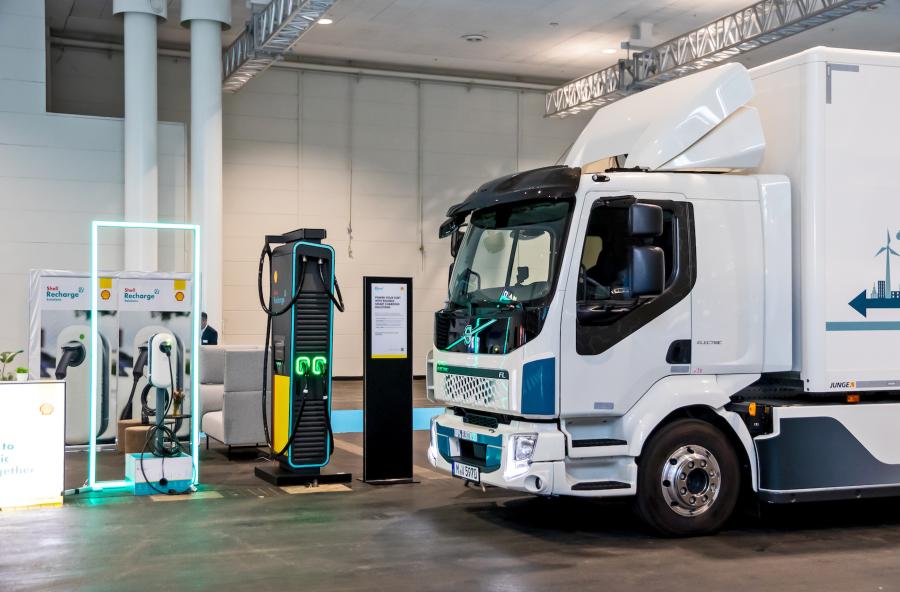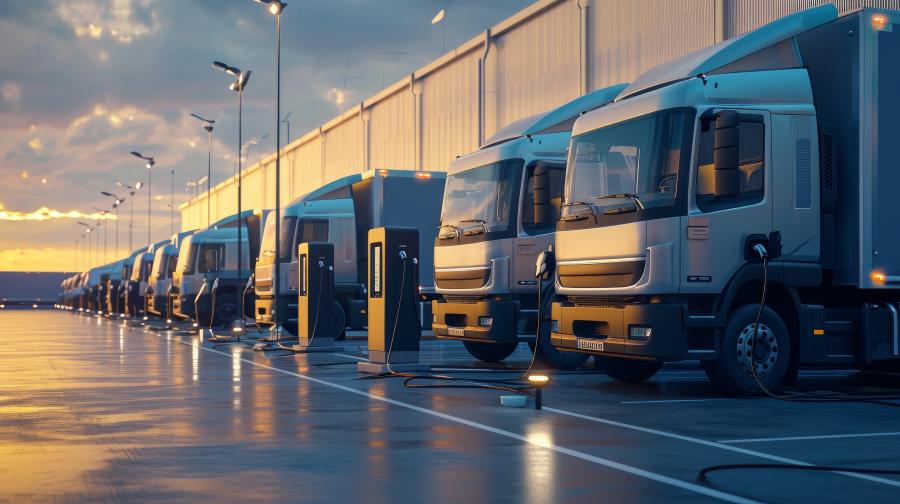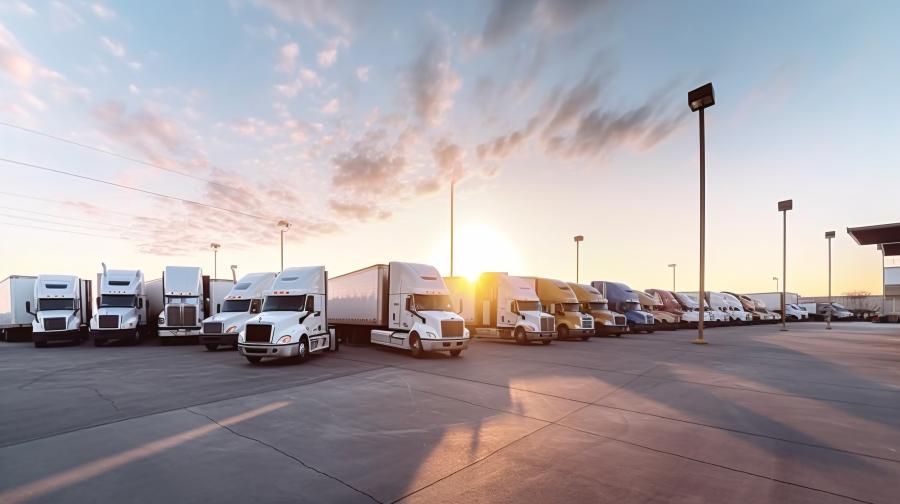
Thu February 08, 2024
Lucy Perry – CEG CORRESPONDENT
Heavy truck manufacturers are all-in on the Biden administration's zero-emissions goals. To prove it, a manufacturers coalition has launched a campaign to push zero-emission vehicle (ZEV) infrastructure. Biden's transportation department, doling out grants to build up the electric truck charging grid, are also helping move the industry toward greener pastures.
Launched in January, Powering America's Commercial Transportation (PACT) was formed by Daimler Truck North America, Navistar Inc. and Volvo Group North America.
With a goal of "overcoming the many barriers delaying access to ZEV infrastructure," PACT also wants climate policy to address infrastructure needs.
"Decarbonizing the commercial transportation sector … is critical to meeting our nation's climate goals," said John O'Leary, Daimler president and CEO. "But the transition to zero-emission vehicles is stalling without the deployment of the needed charging infrastructure."
The aim, he added, is to accelerate infrastructure buildout so fleets can adopt ZEVs, "and we can all benefit from emissions reductions as quickly as possible."
Going for Electrification Gold
The three truck makers collectively represent 70 percent of all new M/HD truck sales in the United States and have on their radar "ambitious" electrification goals.
PACT maintains access to charging infrastructure is an increasingly significant bottleneck to the widespread adoption of these technologies.
Stakeholders who want to see the deployment of zero-emission commercial vehicles and the requisite infrastructure, are welcome to join. That includes other OEMs, infrastructure developers, electric utilities and grid operators.
PACT reports other founding members include ABB E-mobility, Burns & McDonnell, Greenlane, J.B. Hunt Transport Inc., Prologis Inc. and Voltera.
The coalition believes that so far U.S. transportation electrification has focused on light-duty passenger vehicles. That's "a far different market segment that does not require the same unique considerations" as medium/heavy-duty trucks.
Rapid deployment of reliable ZEV infrastructure requires "distinct considerations" in capital, electricity and equipment. The International Council on Clean Transportation believes some 700,000 chargers will be needed for the million Class 4-8 M/HD/ZEVs by 2030.

Adobe Stock Photo
That system will eat up 140,000 megawatts of electricity every day, equivalent to the monthly energy needs of more than 100 million American homes.
Commercial vehicle customers require fast, reliable, affordable and convenient power, said Mathias Carlbaum, Navistar president and CEO. Industry must deliver "infrastructure that provides access to seamless electricity and meets the commercial transportation industry's unique needs."
Carlbaum believes PACT provides a forum to make the vision a reality, "truly working to accelerate the impact of sustainable mobility."
Stephen Roy, Volvo Group chair, describes the scale of infrastructure for M/HD EV adoption as "unprecedented."
He believes that understanding and coordination across the different stakeholders are imperative to deploy chargers quickly and cost-effectively.
"PACT will promote best practices to streamline this complex transition while minimizing impacts on fleets, utilities and the economy."
The coalition promises that in supporting ZEV infrastructure, no specific vehicle, power generation or utility distribution technology will be promoted.
"PACT exists to educate stakeholders about infrastructure challenges that hamper M/HD ZEV adoption in the marketplace," the organization said.
It exists, as well, to work with stakeholders to find solutions for the benefit of all interested parties.
"The coalition also champions practical and efficient infrastructure solutions capable of supporting increasing M/HD ZEV deployments."
The companies' decision to join forces underscores how critical industry support of government is to the transition away from fossil fuels.
More Power Access Needed Now
In a January New York Times article, Jack Ewing reported that officials are just beginning to distribute $1 billion in Inflation Reduction Act funding.
He said truck manufacturers have complained that they have gotten less attention from federal and state governments than makers of cars.
"There's a lot of funding that's available out there from the federal government," said Dawn Fenton, a Volvo Group vice president. "There's been little so far focused on the heavy-duty charging infrastructure."
According to the New York Times article, DOE knows of only nine fast-charging stations serving heavy trucks, and that's tough on manufacturers and truckers.
The truck makers say they can't sell battery-powered trucks when there are hardly any places to charge them. Electric trucks require bigger connections to the electrical grid than are readily available.
Utilities are upgrading distribution lines, transformers and equipment to deliver the energy needed to refuel multiple trucks simultaneously, reports the New York Times.
In one example, a Navistar customer installed 20 chargers at its depot, but couldn't get it energized by the utility, said Brien Sheahan of Navistar.
He believes the electrical grid's weaknesses are going to put a strain on industry's ability to scale itself. That may change if the nation follows California's lead. Three megawatt-scale truck charging stations are being built with $75 million in federal grants.
The Golden State leads in the national transition away from fossil fuels. It's also first in the drive to build out more electric truck stops and depots. California transportation service provider WattEV announced it would launch the three E-truck charging depots using federal grants.
The company plans to work with local government to build two along the I-5 corridor in Central Valley and another along the California-Arizona border.
The three will offer a combined 258 charging points. They will include megawatts of solar panels and battery storage to reduce the draw on power grids.
According to Canary Media, WattEV also will launch its megawatt charging stations, providing faster charging than today's direct-current fast chargers.
The two Central Valley sites will have 17 megawatt chargers alongside 175 standard DC fast chargers capable of delivering 350 kilowatts, reports Canary.
"The technology standards for megawatt charging systems are still in development, and no electric trucks on the road are capable of using them today," wrote Jeff St. John.
Salim Youssefzadeh, WattEV CEO, said that planning ahead to support megawatt-scale charging is crucial to expanding electric trucks ranges.

Adobe Stock Photo
"Today's still-rare electric big rigs mainly run daily routes between ports and warehouses and delivery points," said St. John.
Test drives have proven electric trucks can handle the sub-100-mi. routes that make up the majority of freight-hauling trips today. The latest heavy-duty electric trucks can go hundreds of miles between charges, according to St. John.
But WattEV wants to see its sites as long-haul hubs for the most challenging set of trucks to electrify.
That's rigs that carry freight long distances on interstate and cross-country routes. "Being able to plan for the future is critical," said Youssefzadeh.
Several depot developers have eyes on the long-haul trucking sector and drayage trucks moving cargo from ports to warehouses are their target.
These are the initial fleets slated for conversion to zero-emissions models under California's ambitious Advanced Clean Fleets rule.
Two other depot developers, Forum Mobility and TeraWatt Infrastructure, are hoping to set up business at Southern California ports.
Forum is offering electric trucks from Long Beach and is building more charging depots between California ports and inland distribution hubs. St. John reported that TeraWatt has started building truck-charging sites near various ports, including one at Rancho Dominguez, south of Los Angeles.
With dual purposes, these sites can be used for more local traffic. Some 80 percent of truck routes are less than 200 miles, said Neha Palmer, TeraWatt CEO.
TeraWatt's Rancho Dominguez site will be used for "last-mile" electric-truck charging. "But they can also be used by trucks going further afield," she said.
TeraWatt's has a larger goal to build charging depots on the I-10 from California to Texas. The company is identifying the Phoenix area to start.
But building truck-charging sites at scale takes money. WattEV is focusing on federal and state grants, in addition to private funds, for its depot launches.
CEO Youssefzadeh said the private funds should allow his company "to grow significantly … to 400-plus sites we plan to bring online, hopefully soon."
St. John said WattEV hasn't disclosed exactly where all those future charging stations will be. But the company is eyeing spots in California and Oregon to serve trucks traveling the I-5 corridor from Southern California north to the Canadian border.
Making the Biggest Impact
Southern California is the most active zero-emissions market, but E-trucks number fewer than 300 of the roughly 1.8 million under the state's green fleet rules.
Ray Minjares, director of HD vehicles for the International Council on Clean Transportation, said grants and incentives for early-adopter markets like California are a positive step.

Adobe Stock Photo
ICCT found that a majority of EPA's pending trucking emissions reductions could be supported by investing in a handful of major freight corridors in California.
"This is about how you can increase the number of electric miles in the U.S.," Minjares told Canary Media. "We talk about the sales of vehicles. But it's actually about the energy they're consuming."
He said that's especially true of the source of vehicle miles consuming the most energy, which is long-haul tractors.
In 2023, Minjares and colleague Yihao Xie created maps showing where long-haul truck charging would offer the greatest impact.
"It makes strategic and economic sense in the near term to electrify the largest number of trucks along the smallest number of roadways where the business case is strongest," they said. CEG
 Truck and Trailer Equipment
Truck and Trailer Equipment Articles
Articles Email Updates
Email Updates Sell Your Machines
Sell Your Machines

 Truck and Trailer Equipment
Truck and Trailer Equipment Truck and Trailer Dealers
Truck and Trailer Dealers Truck and Trailer Articles
Truck and Trailer Articles Email Updates
Email Updates Sell Your Machines
Sell Your Machines